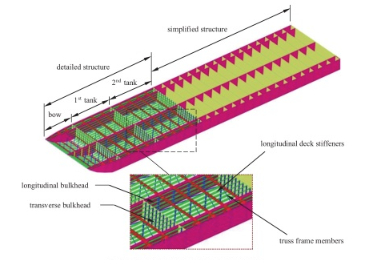Equivalent SPS Compact Double Hull (CDH) Bottom Structure Grounding of Inland Waterway Barges
DOI:
https://doi.org/10.25043/19098642.170Keywords:
equivalent or superior performance, impact resistant hull structure, robust bow construction, Sandwich Plate System (SPS), Compact Double Hull (CDH)Abstract
MARPOL regulations stipulate that all single hull oil carrying barges must be made of double skin construction or modified by an alternate construction provided that the construction ensures at least the same level of protection against oil pollution. It is be demonstrated that the proposed alternative method of design, made with a SPS Compact Double Hull (CDH) applied to the bottom hull, does not rupture under the prescribed grounding event (no rupture, no oil outflow, no oil pollution).
A sophisticated finite element model was developed to simulate the grounding event for a single hull barge. Based on the experience gained from this simulation, a comparative grounding simulation study was conducted where a specified embedded object causes rupture of the outer and inner hull for double hull construction (a non-zero probability of oil outflow and pollution) and no rupture of the SPS CDH which demonstrates superior performance.
Downloads
References
AMERICAN BUREAU OF SHIPPING, 2016, ABS Rules for Building and Classing Steel Vessels for Service on Rivers & Intracoastal Waterways, American Bureau of Shipping, Houston, TX, USA.
INTELLIGENT ENGINEERING, 2016, Equivalent SPS Compact Double Hull (CDH) Bottom Structure for Grounding of Inland Waterway Barges, Intelligent Engineering, Ottawa, Ontario, Canada.
INTERNATIONAL MARITIME ORGANIZATION, 1973, International Convention for the Prevention of Pollution from Ships (MARPOL), International Maritime Organization, London, United Kingdom.
INTERNATIONAL MARITIME ORGANIZATION, 2003, Revised Interim Guidelines for the Approval of Alternative Methods of Design and Construction of Oil Tankers under Regulation 13F(5) of Annex I of MARPOL 73/78”, Resolution MEPC.110 (49), International Maritime Organization, London, United Kingdom.
PICHLER, T. et al., 2012, High-Performance Abaqus Simulations in Soil Mechanics Reloaded – Chances and Frontiers, 2012 Simulia Community Conference, Providence, RI, USA.
SIMULIA, 2016, ABAQUS/CAE 2016 Documentation, Dassault Systemes Simulia Corp., Providence, RI, USA.
SUBRAMANIAN N., 2016, Design of Steel Structures, Oxford University Press, New Delhi, India.
UNITED STATES COAST GUARD, 1994, Navigation and Vessel Inspection Circular No. 15-91, United States Department of Transportation, United States Coast Guard, Washington D.C., USA.

Published
How to Cite
Issue
Section
License
The authors who publish in this Journal certify that:
- The work submitted for publication in The Ship Science and Technology journal, was written by the author, given that its content is the product of his/her direct intellectual contribution.
- All data and references to material already published are duly identified with their respective credits and are included in the bibliographic notes and quotations highlighted as such.
- All materials submitted for publication are completely free of copyrights; consequently, the author accepts responsibility for any lawsuit or claim related with Intellectual Property Rights thereof, Exonerating of responsibility to The Science and Technology for the Development of Naval, Maritime, and Riverine Industry Corporation, COTECMAR.
- In the event that the article is chosen for publication by The Ship Science and Technology journal, the author state that he/she totally transfers reproduction rights of such to The Science and Technology for the Development of Naval, Maritime, and Riverine Industry Corporation, COTECMAR.
- The authors retain the copyright and transfer to COTECMAR the right of publication and reproduction of the work which will be simultaneously subject to the Creative Commons Attribution License (CC -BY) , which allows the license to copy, distribute, display and represent the work and to make derivative works as long as it recognizes and cites the work in the manner specified by the author or licensor.
- For more information about the Creative Commons Attribution License (CC -BY) and his use and scope, please visit the following web page https://creativecommons.org/licenses/by-sa/4.0/legalcode








